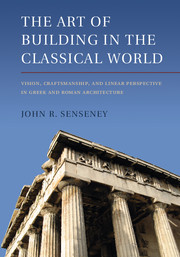 The Art of Building in the Classical World
The Art of Building in the Classical World Book contents
- Frontmatter
- Contents
- List of Figures
- Preface
- Note on Dates and Translations
- Abbreviations
- INTRODUCTION: CHALLENGES OF ANALYSIS AND INTERPRETATION
- 1 THE IDEAS OF ARCHITECTURE
- 2 VISION AND SPATIAL REPRESENTATION
- 3 THE GENESIS OF SCALE DRAWING AND LINEAR PERSPECTIVE
- 4 ARCHITECTURAL VISION
- Excursus: Envisioning Cosmic Mechanism in Plato and Vitruvius
- Appendix A Analysis of the Dimensions of the Blueprint for Entasis at Didyma
- Appendix B Analysis of the Hypothetical Working Drawing for Platform Curvature at Segesta
- Appendix C Analysis of the Hypothetical Working Drawing for Platform Curvature in the Parthenon
- Notes
- References
- Index
Appendix B - Analysis of the Hypothetical Working Drawing for Platform Curvature at Segesta
Published online by Cambridge University Press: 07 October 2011
- Frontmatter
- Contents
- List of Figures
- Preface
- Note on Dates and Translations
- Abbreviations
- INTRODUCTION: CHALLENGES OF ANALYSIS AND INTERPRETATION
- 1 THE IDEAS OF ARCHITECTURE
- 2 VISION AND SPATIAL REPRESENTATION
- 3 THE GENESIS OF SCALE DRAWING AND LINEAR PERSPECTIVE
- 4 ARCHITECTURAL VISION
- Excursus: Envisioning Cosmic Mechanism in Plato and Vitruvius
- Appendix A Analysis of the Dimensions of the Blueprint for Entasis at Didyma
- Appendix B Analysis of the Hypothetical Working Drawing for Platform Curvature at Segesta
- Appendix C Analysis of the Hypothetical Working Drawing for Platform Curvature in the Parthenon
- Notes
- References
- Index
Summary
See Chapter 3 and Figure 61.
If one may accept Haselberger's construction as the method for creating the euthyteria's curvature along its flanks of the temple at Segesta (Figure 61), one may well ask how the architect arrived at a maximum rise of .086 m. An attractive answer may emerge from the internal correspondences of the drawing itself. The maximum ordinate located above the center of the chord is 1.404 m from the center of the arc's diameter: 1.49 m − 0.086 m = 1.404 m.
Given the 1.49 m magnitude of the radius connecting the same center to the ends of the chord, the Pythagorean Theorem confirms Seybold's calculation of the length of the chord as ca. 1 m: with a hypotenuse of 1.49 m, the resulting sides are 1.404 m and .499 m, with the latter doubled to .998 m for the chord's full length. The chord therefore shares an integral 2:3 relationship with the radius of the arc: .998/2 = .499; .499 × 3 = 1.497 m. Despite the similarity of whole-number ratios, one can clearly see that the sagitta of .086 m does not establish modular relationships in the manner of the blueprint at Didyma; to be modular, the relationships would have to be integral, whereas .985 m/.0845 m = 11.166 m, and 1.478 m/.0845 m = 17.491 m.
- Type
- Chapter
- Information
- The Art of Building in the Classical WorldVision, Craftsmanship, and Linear Perspective in Greek and Roman Architecture, pp. 191Publisher: Cambridge University PressPrint publication year: 2011


